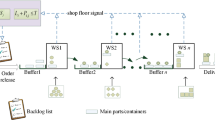Abstract
Pull policies may perform quite differently depending on the particular manufacturing system they must control. Hence, it is clear the necessity of having efficient performance evaluation models to select the best control policy in a specific context. This paper proposes a mathematical programming representation of the main pull control policies applied to single-product serial manufacturing systems. The proposed models simulate the pull controlled system in the sense that, if instantiated with the same parameter values as in a simulation model, their solution gives the same event sequence of the simulation. The proposed mathematical representation is also used for a formal comparison of the considered pull control policies. The new models presented in this paper can represent a base to build new efficient optimization algorithms for the design of pull controlled production systems.
Similar content being viewed by others
References
Baccelli F., Cohen G., Olsder G. J., Quadrat J. P. (1992) Synchronization and linearity: An algebra for discrete event systems. Wiley, New York
Bonvik A. M., Couch C. E., Gershwin S. B. (1997) A comparison of production—line control mechanisms. International Journal of Production Research 35(3): 789–804
Buzacott J. A., Shanthikumar J. G. (1993) Stochastic models of manufacturing systems. Prentice-Hall, New Jersey
Chan, W. K., & Schruben, L. W. (2003). Properties of discrete event systems from their mathematical programming representations. In S. Chick, P. J. Sanchez, D. Ferrin & D. J. Morrice (Eds.), Proceedings of the 2003 Winter Simulation Conference (pp. 496–502). Piscataway, New Jersey: Institute of Electrical and Electronics Engineers, Inc.
Chan W. K., Schruben L. (2008) Optimization models of discrete—event system dynamics. Operations Research 56(5): 1218–1237
Cottenceau B., Hardouin L., Ouerghi I. (2008) Kanban policy improvement thanks to a (max, +)—algebra analysis. International Journal of Systems Science 39: 689–698
Dallery Y., Liberopoulos G. (2000) Extended kanban control system: Combining kanban and base stock. IIE Transactions 32: 369–386
Di Mascolo M., Frein Y., Dallery Y. (1996) An analytical method for performance evaluation of kanban controlled production systems. Operations Research 44(1): 50–64
Duri C., Frein Y., Di Mascolo M. (2000) Comparison among three pull control policies: Kanban, base stock, and generalized kanban. Annals of Operations Research 93: 41–69
Frein Y., Di Mascolo M., Dallery Y. (1995) On the design of generalized kanban control systems. International Journal of Operations and Production Management 15(9): 158–184
Fu M. (2002) Optimization for simulation: Theory vs. practice. Journal on Computing 14(3): 192–215
Gallego G., Ozer O. (2001) Integrating replenishment decisions with advance demand information. Management Science 47(10): 1344–1360
Gaury E. G. A., Pierreval H., Kleijnen J. P. C. (2000) An evolutionary approach to select a pull system among kanban, conwip and hybrid. Journal of Intelligent Manufacturing 11: 157–167
Geraghty, J., & Heavey, C. (2006). A review and comparison of hybrid and pull—type production control strategies. In G. Liberopoulos, C. T. Papadopoulos, B. Tan, J. MacGregor Smith, & S. B. Gershwin (Eds.), In Stochastic modeling of manufacturing systems. Berlin, Heidelberg: Springer.
Hariharan R., Zipkin P. (1995) Customer—order information, lead times and inventories. Management Science 41: 1599–1607
Karaesmen F., Buzacott J. A., Dallery Y. (2002) Integrating advance order information in production control. IIE Transactions 34: 649–662
Karaesmen F., Dallery Y. (2000) A performance comparison of pull type control mechanisms for multi–stage manufacturing. International Journal of Production Economics 68: 59–71
Karaesmen F., Liberopoulos G., Dallery Y. (2004) The value of advance demand information in production/inventory systems. Annals of Operations Research 126: 135–157
Karmarkar N. (1984) A new polynomial time algorithm in linear programming. Combinatorica 4: 373–395
Klee, V., Minty, G. (1972) How good is the simplex algorithm. In O. Shisha (Ed.), Inequalities–III. (pp 159–175). Academic Press, London
Liberopoulos G., Dallery Y. (2000) A unified framework for pull control mechanisms in multi–stage manufacturing systems. Annals of Operations Research 93: 325–355
Matta, A., & Chefson, R. (2005). Formal properties of closed flow lines with limited buffer capacities and random processing times. In Proceedings of the European Simulation and Modelling Conference (pp. 190–194). Porto, Portugal.
Matta A., Dallery Y., Di Mascolo M. (2005) Analysis of assembly systems controlled with kanbans. European Journal of Operational Research 166: 310–336
Ozer O., Wei W. (2004) Inventory control with limited capacity and advance demand information. Operations Research 52: 998–1000
Qi E., Li S. (1995) A deds model for a serial pull system and an analysis of material movements. International Journal of Operations 15(9): 70–88
Schruben, L. W. (2000). Mathematical programming models of discrete event system dynamics. In J. A. Joines, R. R. Bartona, K. Kang, & P. A. Fishwick (Eds.), Proceedings of the 2000 Winter Simulation Conference (pp. 381–385). Piscataway, New Jersey: Institute of Electrical and Electronics Engineers, Inc.
Vanderbei R. J. (2001) Linear programming. Kluwer, Dordrecht
Wijngaard J., Karaesmen F. (2007) On the optimality of order base—stock policies in case of advance demand information in combination with a restricted capacity. OR Spectrum 29: 643–660
Author information
Authors and Affiliations
Corresponding author
Rights and permissions
About this article
Cite this article
Alfieri, A., Matta, A. Mathematical programming representation of pull controlled single-product serial manufacturing systems. J Intell Manuf 23, 23–35 (2012). https://doi.org/10.1007/s10845-009-0371-x
Received:
Accepted:
Published:
Issue Date:
DOI: https://doi.org/10.1007/s10845-009-0371-x




